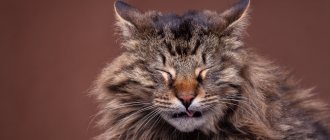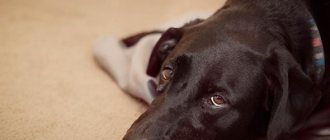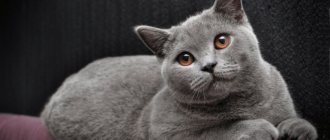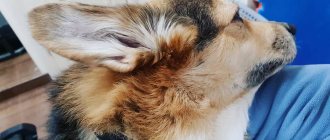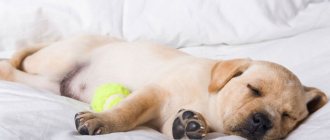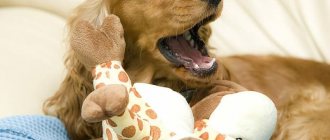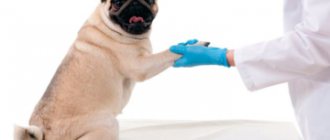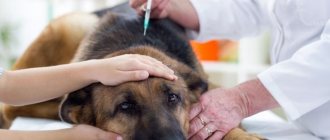What happens to a dog when he reverse sneezes?
Dog owners often turn to veterinary cardiologists because their pets are breathing abnormally, sometimes coughing strangely, and sneezing just as strangely. At such moments, as the owners explain, it seems as if the dog is choking or suffocating. When the attack passes, breathing is restored.
Doctors consider the reverse method of sneezing to be a reverse type of cough and also call it paroxysmal breathing. It's more like a dog gagging. She wants to sneeze, but instead takes several short and convulsive breaths, with grunts and sniffles. If during a normal sneeze the air is suddenly and sharply exhaled through the nostrils, then during the reverse sneezing it is instantly drawn in through the nasal passages. The spasm causes a narrowing of the airways, making it difficult for air to enter the lungs.
Reverse sneezing is called paroxysmal breathing
Reverse sneezing can be recognized by the following symptoms:
- the dog's head is thrown back (and not forward and down, as with normal sneezing);
- The mouth is open and, swallowing saliva, the dog wheezes and gags.
Everything happens noisily and lasts up to 60 seconds.
Causes of reverse sneezing
The causes of reverse sneezing as a physiological phenomenon have not been fully established, but episodes of paroxysmal breathing are believed to occur due to the following factors:
- sticking of the epiglottis and larynx;
- specific anatomy of the nasopharynx;
- the presence of hypertrophied tissues of the soft palate.
Reverse sneezing may be caused by allergies.
The following are identified as provoking factors:
- strong odors and dust, as well as cigarette smoke and fumes from household chemicals;
- allergenic substances;
- nervous excitement;
- haste while eating and drinking;
- tight collar.
Attention! In some cases, reverse sneezing can occur from a sudden temperature change, for example, when a dog enters a house from the street in winter.
Causes
The sneeze reflex is triggered when the nasal mucosa is irritated. It may be associated both with the temporary effect of some factors and with certain diseases.
Main causes of sneezing:
- Acute respiratory infections. By introducing themselves into the mucous membrane, viruses and bacteria irritate it.
- Irritation from dust, various powders, and chemicals suspended in the air. Sometimes this is due to occupational hazards.
- Allergic reactions. Allergens that enter the nasopharynx provoke immune reactions, the development of inflammation, and irritation of the mucous membrane.
- Temperature changes: for example, when a person enters a warm room from a cold place.
- Hormonal changes in the body of a pregnant woman often result in complaints of sneezing.
- Often such a defensive reaction is provoked by strong odors (tobacco smoke, perfumes).
Risk group
There are dog breeds that are predisposed to respiratory problems, including reverse sneezing. We are talking about animals with a brachycephalic head structure:
- Griffons and Pekingese;
- pugs and bulldogs;
- other breeds with a characteristic skull shape.
Bulldogs are predisposed to breathing problems
These animals suffer from what is known as brachiocephalic syndrome, a set of symptoms that are caused by physiologically significant narrowing of the nostrils and nasal passages, as well as an overly long or thick soft palate, coupled with an abnormally shaped larynx and/or trachea.
On a note! The narrower the airways, the more the dog suffers. Against the background of reverse sneezing, wheezing, grunting and other breathing problems that occur constantly, hypoxia develops, which confirms the cyanosis of the oral mucosa. Brachiocephalic manifestations intensify with emotional stress, heat, significant physical activity, and pain.
The structure of the skull in a brachycephalic breed
Symptoms of reverse sneezing in dogs and first aid for your pet
Reverse sneezing affects pets with a special skull structure - the so-called brachycephals. This phenomenon most often occurs in dogs with short muzzles, flattened noses and breathing problems, but other breeds may also experience manifestations of this phenomenon.
Dogs susceptible to reverse sneezing syndrome:
- pugs;
- French and English bulldogs;
- Pekingese;
- boxers;
- Boston Terrier;
- Shih Tzu.
Japanese Chins, which have a shortened facial part of the skull, are also included in this list.
In dogs of small breeds, reverse sneezing occurs more often than in larger dogs of the same species, which is why it is so important for owners of dwarf pets to understand the nature of the phenomenon and not get confused when encountering it.
Contacting a veterinarian
Consultation with a doctor is required if your dog frequently sneezes in this manner. The reasons for this behavior may be the following diseases:
- hypertrophic growth of palatal tissue, which can be caused by tumor processes. This is especially true for older animals;
- allergic reaction, it is important to find out what causes it. Veterinarians believe that antihistamines are vital for such dogs. Increased sensitivity to allergens is manifested not only by sneezing, but also by other signs. This means that the whole body suffers. In addition, dogs with this problem are at risk for anaphylactic shock, a condition that develops suddenly and can cause sudden death. You can read about allergic manifestations in dogs below.
Allergy symptoms in dogs
It happens that in addition to the opposite, regular sneezing and coughing are also observed. If this is accompanied by copious nasal discharge, it may be an infection.
On a note! If, during a sneezing attack, the mucous membranes of the oral cavity turn blue or pale, and the animal faints, respiratory or heart failure is possible. Both are symptoms of dangerous diseases.
A visit to the veterinary clinic will help you understand the causes of reverse sneezing and the accompanying symptoms. Based on the results of the examination, the doctor will prescribe treatment.
Diagnostics
Diagnostics aims to find out the causes of paroxysmal breathing in an animal and differentiate (distinguish) the condition from ordinary coughing and sneezing. In some cases, the study reveals pet pathologies that the owner was not aware of. In the doctor's office, one can only guess how exactly a dog sneezes at home - classically or vice versa. Not every owner can describe the details correctly.
Only a veterinarian can accurately determine the cause and prescribe the correct treatment.
The doctor will first check to see if there is a foreign body in the dog’s respiratory tract, and then, given that normal sneezing can be a sign of pathology, he will suggest examining the dog for certain ailments, such as:
- diseases of the mouth, nose, throat and lower respiratory tract;
- adenoviral, herpetic, parasitic and other infections (if symptoms are present).
A situation in which:
- Episodes of reverse sneezing occur in puppies or young animals. This may indicate the onset of bronchial asthma;
- The dog sneezes this way often. Especially if this happens several times a day, despite the fact that the surrounding air does not have a strong odor and does not contain mechanical particles that, after entering the respiratory tract, could cause their spasm.
Episodes of reverse sneezing most often occur in puppies
The likelihood of health problems in such pets is high, so it is recommended that they be fully examined.
Causes of reverse sneezing in dogs
Among most veterinarians, there is an opinion that it occurs due to nervous overexertion, overexcitation, inhalation of strong strong odors or foreign objects entering the nasopharynx. However, let us turn to the generally accepted premises of reverse breathing:
- allergic reactions to odors, pollen, smoke, fungi or dust;
- reaction to small foreign bodies in the respiratory tract;
- disturbances in the structure of the nasopharynx and respiratory tract;
- sudden change in temperature in the environment;
- increased rate of swallowing food or liquids;
- strong squeezing of the neck by the collar when pulling on the leash during a walk;
- excessive physical activity or lack of oxygen in the room.
When to contact a veterinarian
Immediately after reverse sneezing is first noticed, the dog should be closely monitored. If the situation repeats, there is a suspicion that the problem may become chronic. Consultation with a veterinarian is strictly necessary, because the sooner the presence or absence of pathology is revealed, the easier it will be to rid the dog of such unpleasant processes in the future. Veterinarians will diagnose and determine the causes of reverse sneezing.
Treatment Options
Depending on the dog's condition and the context in which the sneezing occurs, two types of treatment may be prescribed to the animal:
- conservative;
- surgical.
Conservative
Animals prone to allergies must be protected from contact with the source of problems. For example, when a pet reacts by sneezing (reverse and not only) to spraying hairspray, it is better to make the bathroom beautiful. In addition, the dog will need a course of antihistamines. The name, dosage and duration of treatment are determined by the doctor.
Animals prone to allergies must be protected from the allergen
For infectious pathologies, the following medications are indicated:
- medications that help strengthen the immune system;
- antibacterial drugs, which are ideally selected depending on the type of pathogen. Alternatively, broad-spectrum antibiotics may be prescribed;
- antifungal medications;
- means of general strengthening action.
Treating co-infections speeds up relief from reverse sneezing
After eliminating the pathology-cause, attacks of reverse sneezing stop bothering the dog.
Animals with anatomical features of the skull are more at risk than others of respiratory disorders, which develop suddenly and can be very dangerous.
Table 1. Drugs for dogs with brachiocephalic syndrome
| Name of the drug | Image | Action |
| Lasix, Furosemide or other diuretics | Lasix | Diuretic. Helps relieve swelling, including swelling of the respiratory system, removes excess fluid from the body |
| Dexamethasone or Prednisolone | Dexamethasone | Corticosteroids to quickly eliminate massive laryngeal edema. In severe cases, the use of one of these drugs gives a chance to take the animal to a veterinarian. Effective for sudden attacks of allergies, including shock conditions |
| Tavegil | Tavegil | An antihistamine to eliminate the symptoms of an acute allergic reaction |
It is important to know! The listed drugs should be on hand in the form of ampoules with injection solutions, since in emergency cases it is important that the medicine gets into the blood as quickly as possible. In addition, a dog suffering from a choking attack is unlikely to be able to swallow the pill.
Surgical
If the problem is in the anatomy of the respiratory tract, it is solved surgically. Indications for surgery are usually manifestations of brachiocephalic syndrome that contribute to hypoxia, and therefore are life-threatening. In such cases, plastic surgery of the nostrils is performed, and, if necessary, the velum palatine, as well as the laryngeal sacs. Everything happens as planned, after the swelling has been eliminated and the condition has stabilized. The intervention itself is not considered difficult, but the postoperative period is dangerous due to respiratory failure if the swelling returns. To minimize risks, the animal is given a tracheostomy through which it will breathe for the first time after surgery.
Anatomy of the dog's respiratory tract
Reverse Sneezing in Dogs – Causes and Treatments
A reverse sneeze in dogs is a short, heavy and noisy inhalation caused by a sudden spasm of the soft palate, as well as the larynx. Such attacks often bother animals after waking up or during walks.
Reverse sneezing in dogs
What happens to a dog when he reverse sneezes?
Dog owners often turn to veterinary cardiologists because their pets are breathing abnormally, sometimes coughing strangely, and sneezing just as strangely. At such moments, as the owners explain, it seems as if the dog is choking or suffocating. When the attack passes, breathing is restored.
Doctors consider the reverse method of sneezing to be a reverse type of cough and also call it paroxysmal breathing. It's more like a dog gagging.
She wants to sneeze, but instead takes several short and convulsive breaths, with grunts and sniffles. If during a normal sneeze the air is suddenly and sharply exhaled through the nostrils, then during the reverse sneezing it is instantly drawn in through the nasal passages.
The spasm causes a narrowing of the airways, making it difficult for air to enter the lungs.
Reverse sneezing is called paroxysmal breathing
Reverse sneezing can be recognized by the following symptoms:
- the dog's head is thrown back (and not forward and down, as with normal sneezing);
- The mouth is open and, swallowing saliva, the dog wheezes and gags.
Everything happens noisily and lasts up to 60 seconds.
Causes of reverse sneezing
The causes of reverse sneezing as a physiological phenomenon have not been fully established, but episodes of paroxysmal breathing are believed to occur due to the following factors:
- sticking of the epiglottis and larynx;
- specific anatomy of the nasopharynx;
- the presence of hypertrophied tissues of the soft palate.
Reverse sneezing may be caused by allergies.
The following are identified as provoking factors:
- strong odors and dust, as well as cigarette smoke and fumes from household chemicals;
- allergenic substances;
- nervous excitement;
- haste while eating and drinking;
- tight collar.
Attention! In some cases, reverse sneezing can occur from a sudden temperature change, for example, when a dog enters a house from the street in winter.
Risk group
There are dog breeds that are predisposed to respiratory problems, including reverse sneezing. We are talking about animals with a brachycephalic head structure:
- Griffons and Pekingese;
- pugs and bulldogs;
- other breeds with a characteristic skull shape.
Bulldogs are predisposed to breathing problems
These animals suffer from what is known as brachiocephalic syndrome, a set of symptoms that are caused by physiologically significant narrowing of the nostrils and nasal passages, as well as an overly long or thick soft palate, coupled with an abnormally shaped larynx and/or trachea.
On a note! The narrower the airways, the more the dog suffers. Against the background of reverse sneezing, wheezing, grunting and other breathing problems that occur constantly, hypoxia develops, which confirms the cyanosis of the oral mucosa. Brachiocephalic manifestations intensify with emotional stress, heat, significant physical activity, and pain.
The structure of the skull in a brachycephalic breed
Contacting a veterinarian
Consultation with a doctor is required if your dog frequently sneezes in this manner. The reasons for this behavior may be the following diseases:
- hypertrophic growth of palatal tissue, which can be caused by tumor processes. This is especially true for older animals;
- allergic reaction, it is important to find out what causes it. Veterinarians believe that antihistamines are vital for such dogs. Increased sensitivity to allergens is manifested not only by sneezing, but also by other signs. This means that the whole body suffers. In addition, dogs with this problem are at risk for anaphylactic shock, a condition that develops suddenly and can cause sudden death. You can read about allergic manifestations in dogs below.
Allergy symptoms in dogs
It happens that in addition to the opposite, regular sneezing and coughing are also observed. If this is accompanied by copious nasal discharge, it may be an infection.
On a note! If, during a sneezing attack, the mucous membranes of the oral cavity turn blue or pale, and the animal faints, respiratory or heart failure is possible. Both are symptoms of dangerous diseases.
A visit to the veterinary clinic will help you understand the causes of reverse sneezing and the accompanying symptoms. Based on the results of the examination, the doctor will prescribe treatment.
Diagnostics
Diagnostics aims to find out the causes of paroxysmal breathing in an animal and differentiate (distinguish) the condition from ordinary coughing and sneezing.
In some cases, the study reveals pet pathologies that the owner was not aware of. In the doctor's office, one can only guess how exactly a dog sneezes at home - classically or vice versa.
Not every owner can describe the details correctly.
Only a veterinarian can accurately determine the cause and prescribe the correct treatment.
The doctor will first check to see if there is a foreign body in the dog’s respiratory tract, and then, given that normal sneezing can be a sign of pathology, he will suggest examining the dog for certain ailments, such as:
- diseases of the mouth, nose, throat and lower respiratory tract;
- adenoviral, herpetic, parasitic and other infections (if symptoms are present).
A situation in which:
- Episodes of reverse sneezing occur in puppies or young animals. This may indicate the onset of bronchial asthma;
- The dog sneezes this way often. Especially if this happens several times a day, despite the fact that the surrounding air does not have a strong odor and does not contain mechanical particles that, after entering the respiratory tract, could cause their spasm.
Episodes of reverse sneezing most often occur in puppies
The likelihood of health problems in such pets is high, so it is recommended that they be fully examined.
Treatment Options
Depending on the dog's condition and the context in which the sneezing occurs, two types of treatment may be prescribed to the animal:
- conservative;
- surgical.
Conservative
Animals prone to allergies must be protected from contact with the source of problems. For example, when a pet reacts by sneezing (reverse and not only) to spraying hairspray, it is better to make the bathroom beautiful. In addition, the dog will need a course of antihistamines. The name, dosage and duration of treatment are determined by the doctor.
Animals prone to allergies must be protected from the allergen
For infectious pathologies, the following medications are indicated:
- medications that help strengthen the immune system;
- antibacterial drugs, which are ideally selected depending on the type of pathogen. Alternatively, broad-spectrum antibiotics may be prescribed;
- antifungal medications;
- means of general strengthening action.
Treating co-infections speeds up relief from reverse sneezing
After eliminating the pathology-cause, attacks of reverse sneezing stop bothering the dog.
Animals with anatomical features of the skull are more at risk than others of respiratory disorders, which develop suddenly and can be very dangerous.
Table 1. Drugs for dogs with brachiocephalic syndrome
Name of the drug Image Action
| Lasix, Furosemide or other diuretics | Lasix | Diuretic. Helps relieve swelling, including swelling of the respiratory system, removes excess fluid from the body |
| Dexamethasone or Prednisolone | Dexamethasone | Corticosteroids to quickly eliminate massive laryngeal edema. In severe cases, the use of one of these drugs gives a chance to take the animal to a veterinarian. Effective for sudden attacks of allergies, including shock conditions |
| Tavegil | Tavegil | An antihistamine to eliminate the symptoms of an acute allergic reaction |
It is important to know! The listed drugs should be on hand in the form of ampoules with injection solutions, since in emergency cases it is important that the medicine gets into the blood as quickly as possible. In addition, a dog suffering from a choking attack is unlikely to be able to swallow the pill.
Surgical
If the problem is in the anatomy of the respiratory tract, it is solved surgically. Indications for surgery are usually manifestations of brachiocephalic syndrome that contribute to hypoxia, and therefore are life-threatening. In such cases, plastic surgery of the nostrils is performed, and, if necessary, the velum palatine, as well as the laryngeal sacs.
Everything happens as planned, after the swelling has been eliminated and the condition has stabilized. The intervention itself is not considered difficult, but the postoperative period is dangerous due to respiratory failure if the swelling returns.
To minimize risks, the animal is given a tracheostomy through which it will breathe for the first time after surgery.
Anatomy of the dog's respiratory tract
How to relieve your pet's seizure
If an animal suffers from frequent attacks, it can be helped. This is done like this:
- the dog is stroked on the neck in the larynx area. This stimulates swallowing movements, relaxes the throat muscles, and also allows the pet to restore normal breathing;
- Gently cover the dog’s nostrils with your palm so that he begins to breathe through his mouth. After a deep breath, the attack will stop. If this does not happen, it is recommended to try again, while stroking the dog’s throat with the other hand.
During an attack, you need to stroke the dog on the neck in the larynx area
The following actions are also considered as alternative assistance options:
- grab the dog's nose and blow into the nostrils;
- give the animal water.
This is usually enough for the dog to calm down and breathe evenly.
You can see what happens to an animal during an attack of reverse sneezing and how to help it here:
Conclusion
Reverse sneezing occurs in healthy dogs, but is rare. When the problem bothers you periodically, the cause may be illness. To save the life and restore the health of your animal, it is necessary to examine and treat it.
Source: https://pets-expert.ru/obratnoe-chixanie-u-sobak/
How to relieve your pet's seizure
If an animal suffers from frequent attacks, it can be helped. This is done like this:
- the dog is stroked on the neck in the larynx area. This stimulates swallowing movements, relaxes the throat muscles, and also allows the pet to restore normal breathing;
- Gently cover the dog’s nostrils with your palm so that he begins to breathe through his mouth. After a deep breath, the attack will stop. If this does not happen, it is recommended to try again, while stroking the dog’s throat with the other hand.
During an attack, you need to stroke the dog on the neck in the larynx area
The following actions are also considered as alternative assistance options:
- grab the dog's nose and blow into the nostrils;
- give the animal water.
This is usually enough for the dog to calm down and breathe evenly.
You can see what happens to an animal during an attack of reverse sneezing and how to help it here:



